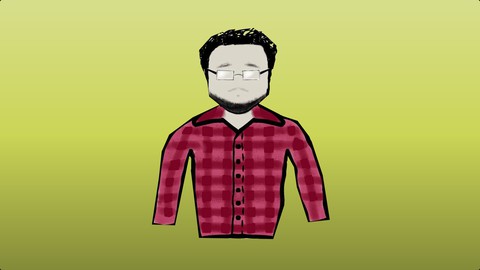
The Extensive WebGL Series ! – Part1 : Low Level Graphics
The Extensive WebGL Series ! – Part1 : Low Level Graphics, available at $44.99, has an average rating of 3.85, with 80 lectures, based on 240 reviews, and has 3331 subscribers.
You will learn about create nice 3D scenes that run directly on the browser inside HTML elements. understand how to write code that runs directly on the gpu, and how to communicate with it from the cpu. understand the low level mathematics related to computer graphics. This course is ideal for individuals who are Any programmer interested in computer graphics, specially but not necessarily on the web. or Any web developer who wants to add 3D graphics to his websites as a sort of astonishing styling. or Anyone interested in understanding the low level internals of how the graphics pipeline works. or Anyone interested in the mathematics of computer graphics. or Any High-level game developer who wants to dig deeper into understanding what really happens behind the scene in his high-level code It is particularly useful for Any programmer interested in computer graphics, specially but not necessarily on the web. or Any web developer who wants to add 3D graphics to his websites as a sort of astonishing styling. or Anyone interested in understanding the low level internals of how the graphics pipeline works. or Anyone interested in the mathematics of computer graphics. or Any High-level game developer who wants to dig deeper into understanding what really happens behind the scene in his high-level code.
Enroll now: The Extensive WebGL Series ! – Part1 : Low Level Graphics
Summary
Title: The Extensive WebGL Series ! – Part1 : Low Level Graphics
Price: $44.99
Average Rating: 3.85
Number of Lectures: 80
Number of Published Lectures: 80
Number of Curriculum Items: 80
Number of Published Curriculum Objects: 80
Original Price: $69.99
Quality Status: approved
Status: Live
What You Will Learn
- create nice 3D scenes that run directly on the browser inside HTML elements.
- understand how to write code that runs directly on the gpu, and how to communicate with it from the cpu.
- understand the low level mathematics related to computer graphics.
Who Should Attend
- Any programmer interested in computer graphics, specially but not necessarily on the web.
- Any web developer who wants to add 3D graphics to his websites as a sort of astonishing styling.
- Anyone interested in understanding the low level internals of how the graphics pipeline works.
- Anyone interested in the mathematics of computer graphics.
- Any High-level game developer who wants to dig deeper into understanding what really happens behind the scene in his high-level code
Target Audiences
- Any programmer interested in computer graphics, specially but not necessarily on the web.
- Any web developer who wants to add 3D graphics to his websites as a sort of astonishing styling.
- Anyone interested in understanding the low level internals of how the graphics pipeline works.
- Anyone interested in the mathematics of computer graphics.
- Any High-level game developer who wants to dig deeper into understanding what really happens behind the scene in his high-level code
This course covers the fundamentals of computer graphics programming using WebGL2.In the course, we will walk together in two complementary and interleaving tracks. The first track will cover the mathematical foundations of computer graphics. This will include illustrations, examples, and proofs. I do not require you to have strong mathematical background for this as I will illustrate almost everything you need. You only need to know simple basics such as matrices, vectors, dot products, and cross products. The second track will cover the conversion of these concepts into actual code implementation. In this track, you will learn how to manipulate your graphics card (GPU) to perform the required graphics calculations for you. You will learn how to write code that runs directly on the GPU (using GLSL ), and how to communicate with it using your code that runs on the CPU (using JavaScript). Again I do not require you to even know JavaScript although it certainly will help. I do require you, however, to have good knowledge of at least one programming language. Words like variables, arrays, functions, or objects must be familiar to you.
That said, those two tracks are not delivered one after the other. Instead, they are interleaved. I lay the theoretical and mathematical foundation for some concept, and then follow up by the practical implementation in code. Then repeat.
While this course focuses on graphics programming on the web, you will actually find this course equally useful if you wish to learn computer graphics fundamentals on any other platform, and you will be able to switch with minimum effort. WebGLis only a tool.
This course is a low-level programming course. You will send the required data to the GPU byte by byte. While this will not make you able to create the best game ever in 3 minutes, it will certainly help you gain deep knowledge that you will find extremely useful when you take the next step forwards, as you will actually know what really does happen behind the scene when you use a higher level library in your production code later.
If you encounter any problems of any kind during watching the course, please let me know instantly. I will be quite responsive, and my response will vary from answering in text, supplying more code examples and illustrative articles, to actually re-recording entire videos and supplementary content just for you!
This course is only the beginning. I will follow up with more advanced courses quite soon. Enjoy!
Course Curriculum
Chapter 1: Intro And Exercise Files
Lecture 1: Intro
Lecture 2: Exercise Files
Chapter 2: Fundamentals Of Computer Graphics
Lecture 1: What Is Webgl ?
Lecture 2: Why The GPU ?
Lecture 3: Matrices As Linear Transformations I
Lecture 4: Matrices As Linear Transformations II
Lecture 5: View And Projection
Lecture 6: Need More On Perspective Projection ?
Lecture 7: Shaders
Lecture 8: After The Projection ?
Chapter 3: Your First Triangle !
Lecture 1: The Development Environment
Lecture 2: Hello Triangle I
Lecture 3: Hello Triangle II
Lecture 4: Hello Triangle III
Lecture 5: Hello Triangle IV
Lecture 6: Hello Triangle V
Lecture 7: Hello Triangle VI
Chapter 4: And A Little Bit More ..
Lecture 1: Hello Cube !
Lecture 2: Rotating The Cube I
Lecture 3: Rotating The Cube II
Lecture 4: Multiple Cubes And Refactoring Code
Lecture 5: Instancing
Lecture 6: Changing Colors Over Time
Lecture 7: The Element Array Buffer
Chapter 5: Textures !
Lecture 1: Textures I
Lecture 2: Textures II
Lecture 3: Textures III
Lecture 4: Textures IV
Chapter 6: The Camera !
Lecture 1: Mathematics Of The Camera I
Lecture 2: Mathematics Of The Camera II
Lecture 3: Mathematics Of The Camera III
Lecture 4: Let's Code ! Move The Camera With Your Keyboard
Lecture 5: Rotating The Camera I
Lecture 6: Rotating The Camera II
Lecture 7: Rotating The Camera III
Chapter 7: Lights !
Lecture 1: Colors And Lights
Lecture 2: And One More Refactoring ..
Lecture 3: Lamp Shaders vs Object Shaders
Lecture 4: Lamp On The Screen
Lecture 5: Mathematics Of Diffuse Lighting
Lecture 6: Coding The Diffuse Light I
Lecture 7: Coding The Diffuse Light II
Lecture 8: The Normals Special Transformation Matrix
Lecture 9: Specular Light I
Lecture 10: Specular Light II
Chapter 8: La Finale
Lecture 1: See You Soon !
Chapter 9: Extras Requested By Fellow Students !
Lecture 1: Overview Of The Homogeneous Coordinates
Lecture 2: Homogeneous Coordinates And Intuition Of Perspective Projection
Lecture 3: Perspective Projection Matrix Derivation I
Lecture 4: Perspective Projection Matrix Derivation II
Lecture 5: Perspective Projection Matrix In Code
Chapter 10: Useful Resources And Links
Lecture 1: Useful Resources And Links
Chapter 11: More Linear Algebra !
Lecture 1: About This Section
Lecture 2: Introduction To Computer Graphics !
Lecture 3: The Computer Graphics Pipeline
Lecture 4: Rotation By 90 Degrees in 2D
Lecture 5: Rotation By Arbitrary Angle in 2D
Lecture 6: Orthogonal Matrices And Their Inverse
Lecture 7: Rotation About the X axis in 3D
Lecture 8: Scaling Matrix
Lecture 9: Translation Matrices & The Homogeneous Coordinates
Lecture 10: The Order Of Transformations Matters !
Lecture 11: Reflection Around The X Axis
Lecture 12: Reflection Around Arbitrary Line in 2d – method (I)
Lecture 13: Reflection Around Arbitrary Line In 2D – Method (II)
Lecture 14: Rotation Around Arbitrary Axis in 3D – Method (I)
Lecture 15: Rotation Around Arbitrary Axis In 3D – Method (II)
Lecture 16: Reflection Around Arbitrary Plane In 3D
Lecture 17: Improper Rotations
Lecture 18: Mathematics Of The Camera – I
Lecture 19: Mathematics Of The Camera – II
Lecture 20: Mathematics Of The Camera – III
Lecture 21: Hierarchical Transformations And The Scene Graph
Lecture 22: Robotics And Change Of Reference Frames – I
Lecture 23: Robotics And Change Of Reference Frames – II
Lecture 24: Robotics And Change Of Reference Frames – III
Lecture 25: Robotics And Change Of Reference Frames – IV – Numerical Example In Matlab
Lecture 26: Robotics And Change Of Reference Frames – V – The 3D Case
Lecture 27: Robotics And Change Of Reference Frames – VI – The Camera Matrix Revisited
Chapter 12: Get My Other Courses !
Lecture 1: Get My Other Courses !
Instructors
-
Ahmed Fathy, MSc
MSc, Senior Deep learning engineer @ Affectiva & Instructor
Rating Distribution
- 1 stars: 9 votes
- 2 stars: 16 votes
- 3 stars: 34 votes
- 4 stars: 70 votes
- 5 stars: 111 votes
Frequently Asked Questions
How long do I have access to the course materials?
You can view and review the lecture materials indefinitely, like an on-demand channel.
Can I take my courses with me wherever I go?
Definitely! If you have an internet connection, courses on Udemy are available on any device at any time. If you don’t have an internet connection, some instructors also let their students download course lectures. That’s up to the instructor though, so make sure you get on their good side!
You may also like
- Best Video Editing Courses to Learn in February 2025
- Best Music Production Courses to Learn in February 2025
- Best Animation Courses to Learn in February 2025
- Best Digital Illustration Courses to Learn in February 2025
- Best Renewable Energy Courses to Learn in February 2025
- Best Sustainable Living Courses to Learn in February 2025
- Best Ethical AI Courses to Learn in February 2025
- Best Cybersecurity Fundamentals Courses to Learn in February 2025
- Best Smart Home Technology Courses to Learn in February 2025
- Best Holistic Health Courses to Learn in February 2025
- Best Nutrition And Diet Planning Courses to Learn in February 2025
- Best Yoga Instruction Courses to Learn in February 2025
- Best Stress Management Courses to Learn in February 2025
- Best Mindfulness Meditation Courses to Learn in February 2025
- Best Life Coaching Courses to Learn in February 2025
- Best Career Development Courses to Learn in February 2025
- Best Relationship Building Courses to Learn in February 2025
- Best Parenting Skills Courses to Learn in February 2025
- Best Home Improvement Courses to Learn in February 2025
- Best Gardening Courses to Learn in February 2025






















